My Home Network Step by Step
The Hardware (part 2)
My choice has been an analog modem for a long time,
but today I have an ADSL for
the external connection and ethernet cables for my LAN.
The ADSL signal runs on the telephone wires, along with
the voice signal used by phones.
The phones use low frequency electric waves to transmit
voice; ADSL, on the same cables, put
higher frequencies waves, containing binary data, coded in a very
complicated way, to reach an high speed of many Mbits/sec.
Data and voice travel together and they have to be separated at the
arrival by a splitter.
Low frequency waves, with voice, go to your telephone,
high frequency waves go to an ADSL modem, which extract coded data
from the electrical signals when receiving, and code data into
electrical waves when transmitting.
For an ADSL connection a splitter and a modem are needed.
To connect your computers together and make your LAN,
you need something to which plug all the cables coming from your
computers. This is an ethernet repeater (or an ethernet switch).
The last thing you need is something which manage the traffic and knows
what is directed to each computer an what is directed to the internet.
This is a router.
So you need 4 things: a splitter and a modem to connect to internet
a router and a switch to manage your traffic, and cables of course.
For about 50 euros you can find a little box integrating
the modem, the router, the switch and also a firewall to
protect your network from intruders.
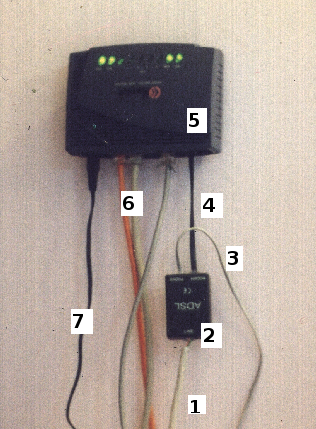
Here is my arrangement (very non-professional indeed)
You can see the cable coming from the main telephone jack (number 1 in the picture),
entering the splitter (at number 2).
From the splitter two cables
start, one, with telephone signals, goes to the telephones (number 3),
the other cable(4) goes to the ADSL modem-router-switch(5).
From the router a number of cables go to the different
rooms of the house(6).
The router power supply cable is at
point 7 in the picture.
The router is a Hamlet
ADSL2+ Modem/Router model HRDSL512P5,
the splitter is from
Matsuyama Electronics, but different brands ships similar products.
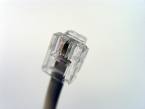
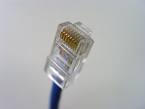
Telephone and computer plugs, and cables, are
different but may be confused, having a
similar shape. Telephone cables are at points:
1,2,3,4 in the picture, computer cables
at point 6.
The telephone plug is named
RJ11,
and has 6 pins, only 2 of which are usually used;
the computer cable plug is named
RJ45 and has 8 pins
(only 4 used for 10-100 Mbit network, 8 for 1000 Mbit).
The computer plug can't fit into the telephone socket, being bigger,
but you can plug the telephone cable into the net socket, obtaining
a non-working connection.
In the pictures Rj11 (left) and RJ 45 plugs (right).
And now cables; short (some meters) patch cords are common in
computer shops, but if you have to cover longer distances
you have to wire your house. You can find a lot of internet
sites explaining how to wire your house; many sites try to
sell you their equipments, others present
semi-professionale installations, but I want simple things,
with minimum expense.
All you need some cable, some RJ45 plugs and a crimping tool, to connect
the plugs to the cables.
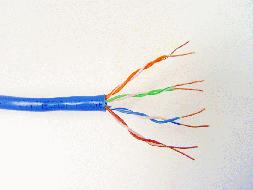
The network cables in use today are twisted
pair category 5e, or category 6. Forget
coaxial cables, they belong to the past.
Twisted pair cables contain
4 pair of little wires, the wires of each pair being wrapped
together to minimize electrical interference.
You can find UTP cables, with no external shielding, or
FTP cables, with a shield foil around the wires.
FTP cables are thicker and more difficult to crimp.
The different cables are well described in the
wikipedia.
The cable cost around 0.30-0.50 euro/meter.
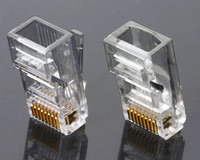
RJ45 connectors : they have to be attached to the cable ends, with
a special tool. You can found shielded or non shielded plugs,
plugs costs less than 1 euro each. A professional crimping tool
can cost about 50 euro, there are also professional tools
for 100 euro or more, and plastic tools
for 10 euro or so, it depends on how many cables you have
to crimp, a plastic tool is easy to be broken, but if it
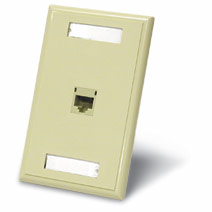
Wall outlet: usually cables are attached
to a wall outlet and a patch cord goes from the outlet
to the computer or the switch. Wall outlet costs about
10 euro each one. To simplify things i didn't use
wall outlet, but crimped
RJ45 plugs directly on the cable coming out of the wall,
very un-professional, but cheap and easy.
So I proceeded in this way: I bough some cable, then used the
same paths in the walls used by the telephone lines to
run the cables through the walls. The professional who
installed telephones in my house used a pair of very thin, unshielded
wires (really, less professional than my home network),
so the path was nearly empty and I had no problem to pull
the UTP cables trough the conduits in the walls.
A fish tape can help you if you have a long path to follow.
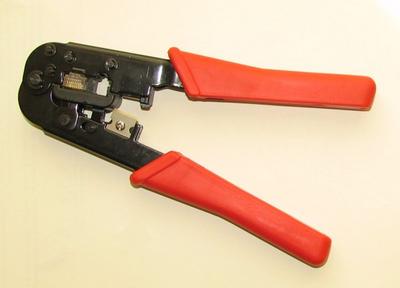
When the cables are in place you have to crimp
connectors to the cable ends.
I found a good description of RJ45 crimping at:
hyperlinesystems Italia
it is in Italian language, but the pictures are very clear.
You have to strip the cable, to unfold he pairs,
carefully fit the pairs in the connector and
to use the crimping tool to block the wires into the
connector.






